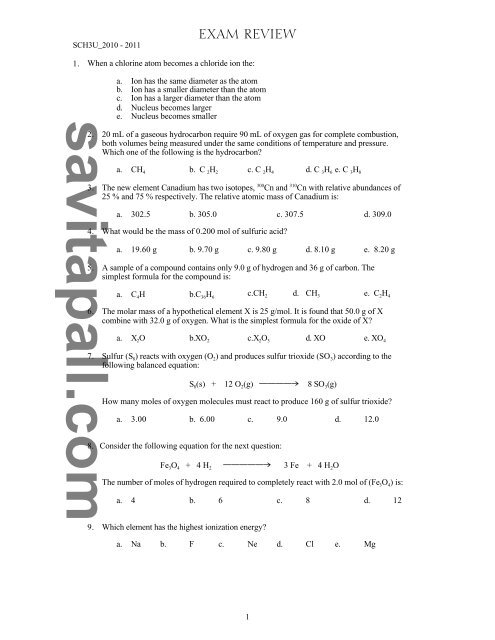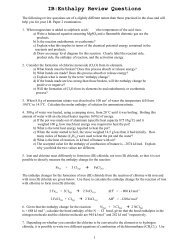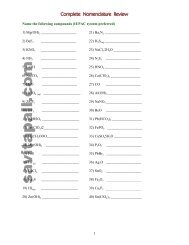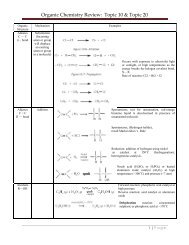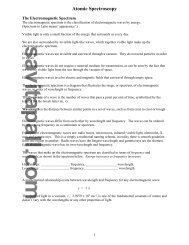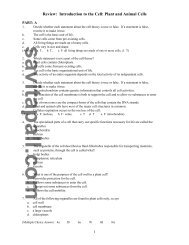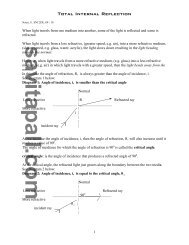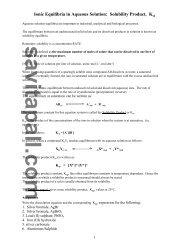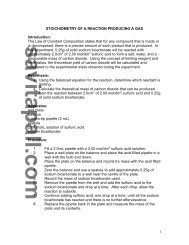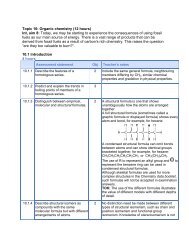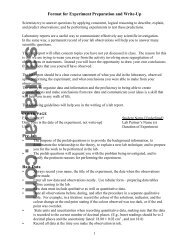Exam Review Questions-3U-June2011 - Savita Pall and Chemistry
Exam Review Questions-3U-June2011 - Savita Pall and Chemistry
Exam Review Questions-3U-June2011 - Savita Pall and Chemistry
Create successful ePaper yourself
Turn your PDF publications into a flip-book with our unique Google optimized e-Paper software.
SCH<strong>3U</strong>_2010 - 2011<br />
EXAM REVIEW<br />
1. When a chlorine atom becomes a chloride ion the:<br />
<br />
a. Ion has the same diameter as the atom<br />
b. Ion has a smaller diameter than the atom<br />
c. Ion has a larger diameter than the atom<br />
d. Nucleus becomes larger<br />
e. Nucleus becomes smaller<br />
2. 20 mL of a gaseous hydrocarbon require 90 mL of oxygen gas for complete combustion,<br />
both volumes being measured under the same conditions of temperature <strong>and</strong> pressure.<br />
Which one of the following is the hydrocarbon?<br />
a. CH 4 b. C 2 H 2 c. C 2 H 4 d. C 3 H 6 e. C 3 H 8<br />
3. The new element Canadium has two isotopes, 300 Cn <strong>and</strong> 310 Cn with relative abundances of<br />
25 % <strong>and</strong> 75 % respectively. The relative atomic mass of Canadium is:<br />
a. 302.5 b. 305.0 c. 307.5 d. 309.0<br />
4. What would be the mass of 0.200 mol of sulfuric acid?<br />
a. 19.60 g b. 9.70 g c. 9.80 g d. 8.10 g e. 8.20 g<br />
5. A sample of a compound contains only 9.0 g of hydrogen <strong>and</strong> 36 g of carbon. The<br />
simplest formula for the compound is:<br />
a. C 4 H b.C 36 H 6<br />
c.CH 2 d. CH 3 e. C 2 H 4<br />
6. The molar mass of a hypothetical element X is 25 g/mol. It is found that 50.0 g of X<br />
combine with 32.0 g of oxygen. What is the simplest formula for the oxide of X?<br />
a. X 2 O b.XO 2 c.X 2 O 3 d. XO e. XO 4<br />
7. Sulfur (S 8 ) reacts with oxygen (O 2 ) <strong>and</strong> produces sulfur trioxide (SO 3 ) according to the<br />
following balanced equation:<br />
S 8 (s) + 12 O 2 (g) ssssd 8 SO 3 (g)<br />
How many moles of oxygen molecules must react to produce 160 g of sulfur trioxide?<br />
a. 3.00 b. 6.00 c. 9.0 d. 12.0<br />
8. Consider the following equation for the next question:<br />
Fe 3 O 4 + 4 H 2 sssssd 3 Fe + 4 H 2 O<br />
The number of moles of hydrogen required to completely react with 2.0 mol of (Fe 3 O 4 ) is:<br />
a. 4 b. 6 c. 8 d. 12<br />
9. Which element has the highest ionization energy?<br />
a. Na b. F c. Ne d. Cl e. Mg<br />
1
The next two questions deal with the identification <strong>and</strong> characterization of three elements<br />
which we shall call X, Y, <strong>and</strong> Z.<br />
The elements have successive atomic numbers each increasing by one in the order given.<br />
Atoms of element Z form stable ions with the formula Z + .<br />
10. Which of the following statements is FALSE concerning elements X, Y, <strong>and</strong> Z?<br />
<br />
a. A neutral atom of element Y would have one more electron than a neutral atom of<br />
element X, but one less electron than a neutral atom of element Z.<br />
b. Element X could be a halogen.<br />
c. Elements X, Y, <strong>and</strong> Z would all be in the same chemical family of the periodic<br />
table.<br />
d. Elements X, Y, <strong>and</strong> Z could be those elements with atomic numbers 9, 10, <strong>and</strong> 11<br />
respectively.<br />
11. Which of the following statements is FALSE concerning the elements X, Y, Z <strong>and</strong> their<br />
ions?<br />
a. The ions X - <strong>and</strong> Z + would have the same number of electrons as neutral atoms of<br />
element Y.<br />
b. Atoms of element Y would react with either those of elements X or Z.<br />
c. Element X would form a compound with hydrogen with the formula HX.<br />
d. Element Z would form a compound with chlorine with the formula ZCl.<br />
e. Elements X <strong>and</strong> Z would react to form a compound with the formula ZX.<br />
12. 1 L of gas in a container at - 73 0 C is allowed to exp<strong>and</strong> to 1.5 L. What must the<br />
temperature be increased to so that the pressure remains constant?<br />
a - 36 0 C b. 0 0 C c. 27 0 C d. 73 0 C<br />
13. During a chemical reaction which of the following statements is true?<br />
a. When one of the products of reaction is a gas the mass of the reactants will be<br />
greater than the mass of the products.<br />
b. When of the products is a precipitate the mass of the products will be greater than<br />
the mass of the reactants.<br />
c. The mass of the products is not dependant on the mass of the reactants.<br />
d. The mass of the products equals the mass of the reactants.<br />
14. A substance that changes the speed of a chemical reaction without being permanently<br />
altered is:<br />
a. A catalytic agent b. A dehydrating agent<br />
c. An oxidizing agent d. A reducing agent<br />
15. Which of the following principles of conservation apply in all chemical reactions having a<br />
balanced equation?<br />
1. conservation of volume<br />
2. conservation of the number of molecules<br />
3. conservation of the number of atoms<br />
4. conservation of mass<br />
a. 1 – 2 – 3 b. 2 – 3 – 4 c. 3 – 4 only d. 1 – 2 only<br />
16. The pressure on 600 cm 3 of gas is increased from 100 kPa to 300 kPa at constant<br />
temperature. What will the new volume of gas be?<br />
a. 200 cm 3 b. 300 cm 3 c. 1200 cm 3 d. 1800 cm 3<br />
2
17. Which of the following equations is not balanced?<br />
a. P 4 + 5 O 2 Y 2 P 2 O 5<br />
b. 2 NCl 3 Y N 2 + Cl 3<br />
c. 2 H 2 O + 2 K 2 O 2 Y O 2 + 4 KOH<br />
d. PbS + 4 H 2 O 2 Y PbSO 4 + 4 H 2 O<br />
18. Which one of the following reactions is not possible?<br />
<br />
a. Na Y Na + + e -<br />
b. F Y F + + e -<br />
c. H 2 Y 2 H + + 2e -<br />
d. Cl Y Cl - + e -<br />
e. Ba Y Ba 2+ + 2e -<br />
19. How many electrons are there in a sulphide ion, S 2- ?<br />
a. 14 b. 15 c. 16 d. 17 e. 18<br />
20. A bromide ion will have a charge of:<br />
a. +1 b. +2 c. +3 d. –1 e. –2<br />
21. An atom of iron 56 26Fe has:<br />
a. 26 protons, 26 electrons, 30 neutrons<br />
b. 30 protons, 30 electrons, 26 neutrons<br />
c. 30 protons, 26 electrons, 26 neutrons<br />
d. 26 protons, 26 electrons, 56 neutrons<br />
e. 26 protons, 30 electrons, 30 neutrons<br />
22. How many electrons are in the outer (highest) energy level of a 39 19K ion?<br />
a. 3 b. 5 c. 6 d. 7 e. 8<br />
23. 8.00 g of NaOH is dissolved in sufficient water to make 200.0 mL of solution. The<br />
concentration of the solution is (in mol/L):<br />
a. 1.00 b. 0.200 c. 0.250 d. 0.500 e. 0.040<br />
24. The atom with an atomic number of 13 will tend to:<br />
a. gain 5 electrons b. gain 3 electrons<br />
c. lose 5 electrons d. lose 3 electrons e. lose 1 electron<br />
25. When sodium reacts with water the products are:<br />
a. H 2 <strong>and</strong> Na 2 O b.H 2 <strong>and</strong> NaOH c. H 2 <strong>and</strong> NaH<br />
d. O 2 <strong>and</strong> NaOH e.O 2 <strong>and</strong> NaH<br />
26. Which of the following is a quantitative chemical property of magnesium?<br />
a. The boiling point of magnesium is 1107EC<br />
b. The density of magnesium is 1.74 g/cm 3<br />
c. Magnesium reacts with chlorine to form magnesium chloride<br />
d. Magnesium is a silvery solid.<br />
e. Magnesium will ignite at 648EC<br />
27. Which of the following elements has the lowest second ionization energy?<br />
a. Na b. K c. Mg d. Ca e. Al<br />
3
28. Zinc + hydrochloric acid produces:<br />
a. hydrogen <strong>and</strong> zinc hydroxide<br />
b. hydrogen <strong>and</strong> zinc chloride<br />
c. hydrogen <strong>and</strong> zinc nitrate<br />
d. chlorine <strong>and</strong> zinc hydride<br />
e. chlorine <strong>and</strong> zinc hydroxide<br />
29. If the molecular mass for a compound having the ratio of carbon to hydrogen atoms,<br />
1 to 1, is 52 g/mol, what would its molecular formula be?<br />
<br />
a. CH b. C 2 H 2 c. C 4 H 4 d. C 5 H 5 e. C 6 H 6<br />
30. What is the molar concentration of OH - ions in pure water?<br />
a) 1.0 x 10 -1 mol L -1 b) 1.0 x 10 -7 mol L -1<br />
c) 1.0 x 10 -10 mol L -1 d) 1.0 x 10 -14 mol L -1<br />
31. Experimentally, a strong acid differs from a weak acid in :<br />
a) concentration b) solubility<br />
c) electrical conductivity d) its reaction with litmus paper<br />
32. Consider the following equation :<br />
HCl + NaOH sssssd NaCl + H 2 O<br />
What mass of NaOH would be required to produce 117 g of NaCl?<br />
a) 117 g b) 58.5 g c) 40 g d) 80 g e) 20 g<br />
33. The concentration of OH - ions in a solution with a pH of 3 is:<br />
a) 1.0 x 10 -3 mol L -1 b) 1.0 x 10 3 mol L -1<br />
c) 1.0 x 10 -1 mol L -1 d) 1.0 x 10 -11 mol L -1<br />
34. The pH at which the colour of an indicator changes is called the :<br />
a) endpoint b) turning point c) equivalence point<br />
d) neutralization point e) titration point<br />
35. Which of the following 1.0 mol L -1 solutions will be the poorest conductor of<br />
electricity ?<br />
a) hydrochloric acid b) acetic acid<br />
c) sodium hydroxide d) sodium chloride<br />
36. If 4.0 g of sodium hydroxide is dissolved in enough water to make 400 mL of solution,<br />
what is the molar concentration of sodium ions in the solution?<br />
a) 10.0 mol L -1 b) 0.40 mol L -1 c) 0.25 mol L -1<br />
d) 0.040 mol L -1 e) 0.010 mol L -1<br />
37. AB 2 is the salt of a strong acid <strong>and</strong> a weak base. A 0.02 mol L -1 solution of this salt is a<br />
saturated solution at 25 0 C. What is the concentration of B - ions in solution?<br />
a) 1.0 x 10 -7 mol L -1 b) 4.0 x 10 -4 mol L -1 c) 1.0 x 10 -3 mol L -1<br />
d) 2.0 x 10 -2 mol L -1 e) 4.0 x 10 -2 mol L -1<br />
38. The pH of tomato juice is 4.5. The [H + ] in tomato juice is:<br />
a) 3.2 x 10 -10 mol L -1 b) 3.2 x 10 -5 mol L -1 c) 5.0 x 10 -4 mol L -1<br />
d) 4.5 mol L -1 e) 3.2 x 10 10 mol L -1<br />
4
39. The boiling point of oxygen is - 183 0 C, <strong>and</strong> its freezing point is - 219 0 C.<br />
Within 50 K of absolute zero, oxygen is a :<br />
a) gas b) liquid c) solid d) solution<br />
40. Which one of the following statements is true?<br />
a) a decrease in pressure on a gas causes a decrease in volume<br />
b) absolute zero is - 273 K<br />
c) an increase in the pressure of a gas could be due to a decrease in the number of<br />
molecules<br />
d) in a mixture of gases, the one with the most molecules exerts the most pressure.<br />
<br />
41. Which one of the following is a basic assumption of the kinetic molecular theory?<br />
a) particles are in constant r<strong>and</strong>om motion<br />
b) particles lose energy with an increase in velocity<br />
c) particles travel faster as the temperature decreases<br />
d) particles lose energy when the temperature increases.<br />
42. A vessel contains 2.50 mol of oxygen gas, 0.50 mol of nitrogen gas <strong>and</strong> 1.00 mol<br />
of carbon dioxide gas. The total pressure is 200 kPa. The partial pressure exerted by the<br />
oxygen gas in the mixture is:<br />
a) 125 kPa b) 150 kPa c) 200 kPa d) 250 kPa<br />
43. The density of an unknown gas is 1.34 g L -1 at STP. The gas could be:<br />
a) F 2 b) Cl 2 c) CH 4 d) CH 2 O<br />
44. A gas occupies 40.0 mL at - 123 0 C. What volume does it occupy at 27 0 C,<br />
assuming pressure is constant?<br />
a) 182 mL b) 8.80 mL c) 80.0 mL d) 20.0 mL<br />
45. A gas occupies a volume of 0.2 L at 25 kPa. What volume will the gas occupy at<br />
2.5 kPa assuming the temperature is kept constant.<br />
a) 0.02 L b) 2 L c) 20 L d) 4 L<br />
46. The following equation represents the electrolysis of water:<br />
2 H 2 O (l) ssssd 2 H 2(g) + O 2(g)<br />
What volume of oxygen gas will be evolved if 360 g of water are electrolyzed at<br />
273 K <strong>and</strong> 101.3 kPa ?<br />
a) 224 L b) 245 L c) 448 L d) 490 L<br />
47. What volume of ammonia, NH 3 , will be produced when 200 L of nitrogen gas<br />
reacts with a sufficient quantity of hydrogen gas at O 0 C <strong>and</strong> 100 kPa according to<br />
the following equation?<br />
N 2(g) + 3 H 2(g) ssssd 2 NH 3(g)<br />
a) 200 L b) 300 L c) 400 L d) 500 L<br />
48. 5.02 g of an unknown gas is sealed in a 1.0 L flask at 37 0 C <strong>and</strong> 3.75 atm. Which<br />
one of the following is most likely to be the unknown gas? (R = 0.0821 atm L K -1 mol -1 )<br />
a) H 2 O b) HBr c) HCN d) H 2 S<br />
5
49. For a substance that remains a gas under the conditions listed, deviation from the<br />
ideal gas law would be most pronounced at :<br />
a) 100 0 C <strong>and</strong> 2.0 atm b) 0 0 C <strong>and</strong> 2.0 atm<br />
c) - 100 0 C <strong>and</strong> 2.0 atm d) - 100 0 C <strong>and</strong> 4.0 atm<br />
50. Given the following equation:<br />
<br />
CaCO 3(s) + 2 HCl (g) ssssd CaCl 2(aq) + H 2 O (l) + CO 2(g)<br />
How many moles of CaCl 2 would one obtain by making 112 L of CO 2 at O 0 C <strong>and</strong><br />
101.3 kPa ?<br />
a) 0.200 mol b) 4.68 mol c) 5.00 mol d) 112 mol<br />
51. What is the correct name of SnSO 3 ?<br />
a) tin (II) sulphite b) tin (IV) sulphite c) stannic sulphite<br />
d) stannic sulphate e) tin (II) sulphate<br />
52. Which of the following is an example of correct Lewis structure?<br />
53. What is the correct name of Pb(OH) 2 C 6H 2 O ?<br />
a. Lead (II) hydroxide heptahydrate b. Lead (II) hydroxide hexahydtare<br />
c. Plumbous hydroxide hydrate d. Lead (IV) hydroxide hydrate<br />
54. 50.0 mL of 0.125 M sulphuric acid solution ( H 2 SO 4(aq) ) is diluted with water to 1.00 L.<br />
The molar concentration of hydrogen ion, H + (aq) in the diluted solution is:<br />
a) 0.00625 M b) 0.0125 M c) 0.125 M d) 0.250 M e) 6.25 M<br />
55. The first four ionization energies of an element X are :<br />
740 kJ mol -1 , 1450 kJ mol -1 , 7730 kJ mol -1 , 10 470 kJ mol -1<br />
The formula for the stable ion of X is most likely to be:<br />
a) X + b) X 2+ c) X 3+ d) X 4+<br />
56. Atoms of the different isotopes of the same element are identical in the:<br />
a) number of electrons b) sum of number of protons <strong>and</strong> neutrons<br />
c) sum of the number of protons <strong>and</strong> neutrons d) mass number<br />
57. The elements X <strong>and</strong> Y have 6 <strong>and</strong>7 electrons respectively, in the highest energy levels of<br />
their atoms. What is the formula <strong>and</strong> type of bonding used in a compound formed by<br />
these elements?<br />
a) XY 2 , ionic b) X 2 Y, ionic c) X 2 Y, covalent d) XY 2 , covalent<br />
6
58. In the periodic table, the elements are arranged in order of increasing:<br />
a) Number of neutrons b) Number of protons<br />
c) Ionization energy d) Electronegativity<br />
59. Which of the following molecules has a pyramidal shape ?<br />
(a) NF 3<br />
(b) H 2 S (c) CCI 4 (d) CO 2<br />
<br />
60. Which one of the following covalent bonds is the most polar?<br />
A. H– O B. H– N C. H– Cl D. H– F<br />
61. Which change in conditions would increase the volume of a fixed mass of gas?<br />
Pressure /kPa Temperature /K<br />
A. Doubled Doubled<br />
B. Halved Halved<br />
C. Doubled Halved<br />
D. Halved Doubled<br />
62. Which is a conjugate acid-base pair in the following reaction?<br />
HNO 3 + H 2 SO 4 qwwwwe H 2 NO 3 + + HSO 4<br />
–<br />
A. HNO 3 <strong>and</strong> H 2 SO 4 B. HNO 3 <strong>and</strong> H 2 NO 3<br />
+<br />
C. HNO 3 <strong>and</strong> HSO 4<br />
–<br />
D. H 2 NO 3 + <strong>and</strong> HSO 4<br />
–<br />
63. Which methods can distinguish between solutions of a strong monoprotic acid <strong>and</strong><br />
a weak monoprotic acid of the same concentration?<br />
I. Add magnesium to each solution <strong>and</strong> measure the rate of the formation of<br />
gas bubbles.<br />
II.<br />
III.<br />
Add pH paper <strong>and</strong> measure the pH change<br />
Use each solution in a circuit with a battery <strong>and</strong> lamp <strong>and</strong> see how bright<br />
the lamp glows.<br />
A. I <strong>and</strong> II only B. I <strong>and</strong> III only C. II <strong>and</strong> III only D. I, II <strong>and</strong> III<br />
64. According to the Bronsted-Lowry theory, the conceptual definition of an acid is<br />
any substance that ________.<br />
(A) Conducts electricity. (B) Reacts with Zn to liberate H2(g).<br />
(C) Gives up protons. (D) Turns litmus red.<br />
7
Problems<br />
1. Explain how the number of electrons in an atom affects atomic radius<br />
2. Using the periodic table, explain the following:<br />
a. Why potassium is more reactive than sodium<br />
b. Why noble gases are assigned a value of zero for electronegativity.<br />
c. Why silicon has a higher ionization energy than sodium.<br />
<br />
d. Explain how first ionization energy is related to atomic radius.<br />
e. Why aluminium has a higher ionization energy than gallium.<br />
f. Why sodium ion is smaller than the sodium atom.<br />
g. Why P -3 ion is larger than P atom.<br />
3. For each of the following molecules:<br />
CF 4 , PH 3 , PH 2<br />
-1<br />
, PH 4<br />
+1<br />
, H 2 Te, BF 3 , BeCl 2 , SO 2<br />
a. Draw the Lewis structure.<br />
b. State the name of the 3– D shape<br />
4. For each of the following:<br />
. give the reaction type<br />
- give a balanced equation<br />
- give phases for each substance<br />
- state the precipitate<br />
- write a total dissociated equation<br />
- write a net-ionic equation<br />
a. Magnesium sulfate reacts with ammonium hydroxide<br />
b. Lead (II) nitrate solution reacts with sodium iodide solution<br />
c. Acetic acid reacts with sodium hydroxide.<br />
d. Strontium chloride reacts with potassium phosphate.<br />
e. Potassium hydroxide reacts with sulphuric acid.<br />
5. An organic compound was found by analysts to contain 40.45% C; 7.86% H <strong>and</strong> 15.73% N.<br />
The remainder was an element commonly found in nature <strong>and</strong> all organic acids … like acetic<br />
acid. (Think !!!)<br />
A separate experiment determined the molecular mass of the compound to be 89.0g mol -1 .<br />
(a) Determine the empirical formula of the compound.<br />
(b) What is the molecular formula of the compound?<br />
8
6. Tin (II) iodide, SnI 2 , can be prepared by adding a solution of potassium iodide, KI (aq) to a<br />
solution of tin (II) chloride, SnCl 2 (aq) , <strong>and</strong> precipitating the insoluble iodide.<br />
2.280 g of SnCl 2 were dissolved in 25.0 cm 3 of water <strong>and</strong> mixed with 10.0 cm 3 of 1.40 mol<br />
L -1 KI (aq) to precipitate the tin (II) iodide.<br />
(i) Write a balanced equation for the reaction of SnCl 2(aq) with KI (aq) .<br />
(ii)Determine the number of mols of each reactant.<br />
(iii) Determine which of the reagents is present in excess nad which reagent is the limiting<br />
reagent.<br />
<br />
(iv) Calculate the maximum mass of tin (II) iodide that could be formed<br />
(v) In an experiment carried out as described above, 1.89 g of tin (II) iodide was obtained.<br />
Determine the percentage yield.<br />
7. A 0.496 g of an unknown hydrocarbon, (a compound containing just carbon <strong>and</strong> hydrogen)<br />
was completely burned in oxygen. The sample produced 1.5 6 g of carbon dioxide <strong>and</strong> 0.638<br />
g of water.<br />
(a)<br />
(b)<br />
(c)<br />
(i) How many moles of carbon dioxide were formed?<br />
(ii) How many moles of water were formed?<br />
(iii) What is the empirical formula of the hydrocarbon?<br />
A 1.12 g sample of the hydrocarbon occupied 448 cm 3 at 0 ºC <strong>and</strong> 101.3 kPa pressure. What<br />
is the molecular mass of the compound? (1.00 mol of any gas occupies 22.4 L at 0ºC <strong>and</strong><br />
101.3 kPa, a.k.a.: STP)<br />
What is the molecular formula of the compound?<br />
8. Lead (II) nitrate, Pb(NO 3 ) 2 , reacts with sodium iodide, NaI. One of the products is a yellow<br />
precipitate. How much precipitate would be produced if 6.00 g of sodium iodide was used<br />
with sufficient NaI?<br />
9. If hydrogen gas occupies 44. 8 L at STP, at what pressure will the sample occupy 112 L when<br />
the temperature is fixed at 30 0 C ?<br />
10. What is the volume occupied by 4.4 g carbon dioxide gas at a temperature of 30.0 O C <strong>and</strong> a<br />
pressure of 99.6 kPa?<br />
11. What is the density of sulphur dioxide gas, SO 2 , if 6.40 g exerts a pressure of 98.8 kPa at a<br />
temperature of 23.5 O C ?<br />
12. Calcium oxide, CaO, reacts with carbon dioxide to produce calcium carbonate, CaCO 3 . If<br />
10.0 L of carbon dioxide at 5.00 0 C <strong>and</strong> 121.2 kPa reacts with the calcium oxide, what mass<br />
of calcium carbonate will be produced?<br />
13. What mass of sodium phosphate, Na 3 PO 4, was used to produce 250 mL of 0.100 mol/L<br />
solution?<br />
14. A 145.0 mL sample of sulphuric acid reacts completely with zinc metal to produce 125.0<br />
mL of hydrogen gas at 22.0 O C <strong>and</strong> a pressure of 102.3 kPa.<br />
What is the<br />
molar concentration of the sulphuric acid?<br />
9
15. Tums, essentially calcium carbonate, CaCO 3, on the market are sold as an antacid. A tablet<br />
of Tums was crushed <strong>and</strong> reacted with hydrochloric acid, HCl (aq) . 28.50 mL of 0.200 mol L -1<br />
hydrochloric acid was required to completely neutralize one of the Tums tablet.<br />
a. Write a balanced equation for the reaction of the Tums tablet, (CaCO 3 (s) ) with hydrochloric<br />
acid, HCl (aq) .<br />
b. Write a net-ionic equation.<br />
c. Determine the mols of hydrochloric acid consumed.<br />
d. Determine the mols of Tums consumed.<br />
e. Determine the mass of the CaCO 3(s) in each of the Tums tablet.<br />
<br />
16. How much 15.4 mol/L nitric acid is needed so that the dilution results in 150 mL of 0.200<br />
mol/L solution of the nitric acid.<br />
17. A chemist makes nitroglycerin, C 3 H 5 (NO 3 ) 3 from glycerol C 3 H 5 (OH) 3 <strong>and</strong> HNO 3 .<br />
The balanced chemical reaction is listed below:<br />
C 3 H 5 (OH) 3(l) + 3 HNO 3 (aq) sssssd C 3 H 5 (NO 3 ) 3 (l) + 3 H 2 O (l)<br />
If 4.1 g of glycerol <strong>and</strong> 13.5 g of HNO 3 are used to produce 8.80 g of nitroglycerin:<br />
a. What is the limiting reagent?<br />
b. What is the theoretical yield of nitroglycerin?<br />
c. What is the actual yield of nitroglycerin?<br />
d. What is the percentage yield of nitroglycerin?<br />
18. If 26.55 mL of LiOH are required to neutralize 21.70 mL of 0.500 mol/L HBr (aq) what is the<br />
concentration of the base?<br />
19. How many grams of table sugar C 12 H 22 O 11 are contained in 50.0 mL of a 0.400 mol/L<br />
solution of sugar in water?<br />
20. What is the molar mass of a vapour, 0.842 g of which occupies 450 mL at a pressure of 100<br />
kPa <strong>and</strong> a temperature of 100 0 C?<br />
21. How many litres of hydrogen gas at 23.0EC <strong>and</strong> 103.0 kPa can be obtained by the reaction<br />
of 75.0 g of aluminium with excess sulfuric acid?<br />
2 Al(s) + 3 H 2 SO 4 (aq) ssssd A1 2 (S0 4 ) 3 (aq) + 3 H 2 (g)<br />
22. A gas occupies 0.045 L at 240K <strong>and</strong> 100 kPa. When the pressure is changed, the volume<br />
becomes 0.015 L at a temperature of 300K. What is the new pressure?<br />
23. 8.0 L of a gas is kept at constant pressure. The temperature is changed to 580 K, <strong>and</strong> the gas<br />
now occupies 20.0 L. What was the initial temperature?<br />
24. A gas occupies 1.0 L container at 20 O C <strong>and</strong> 50.0 kPa, it is transferred into a 250 mL<br />
container <strong>and</strong> is subjected to a pressure of 200.0 kPa, what will be the new temperature of<br />
the gas?<br />
25. A white powder is a mixture of X mol of hydrated magnesium sulfate (MgSO 4 ! 7H 2 O,<br />
Relative Molecular Mass = 246.5) <strong>and</strong> Y ml of hydrated zinc sulfate (ZnSO 4 ! 7H 2 O,<br />
Relative Molecular Mass = 287.5).<br />
0.3973 g of the powder was dissolved in water <strong>and</strong> an excess of barium chloride solution<br />
was added to precipitate barium sulfate. This precipitate was filtered off, dried <strong>and</strong><br />
weighted. The mass of barium sulfate isolated was 0.3550 g.<br />
(a) How many mol of barium sulfate were precipitated?<br />
(b) In terms of X <strong>and</strong> Y, what is the total number of the two compounds in the weighted sample of<br />
mixture?<br />
(c) Stated also in terms of X <strong>and</strong> Y, what is the total number of mol of sulfate in the sample which<br />
was tested?<br />
(d) Calculate the numerical value of X.<br />
(e) What is the percentage by weight of hydrated magnesium sulfate in the mixture?<br />
10


